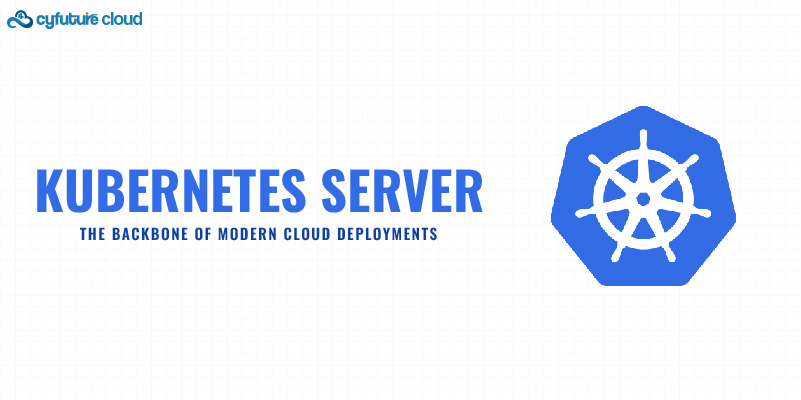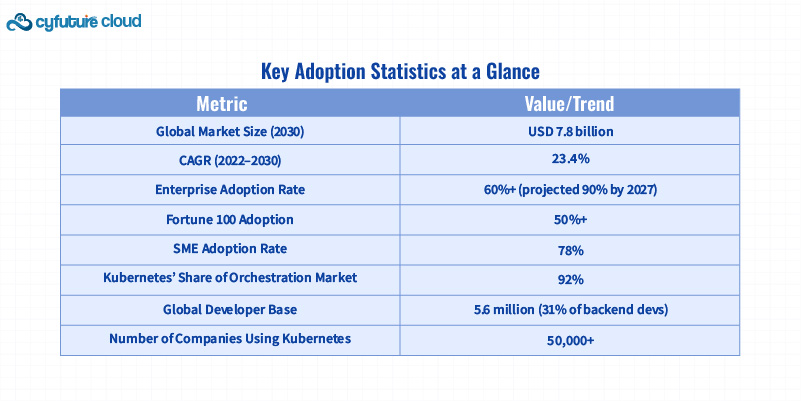Table of Contents
- What is a Kubernetes Server?
- The Meteoric Rise of Kubernetes
- Why Kubernetes Servers Matter for Modern Businesses
- Key Challenges and Solutions in Kubernetes Server Management
- Best Practices:
- Managed Kubernetes Servers: Simplicity Meets Power
- Kubernetes Server Monitoring: The Linchpin of Reliability
- Facts & Figures: Kubernetes Server in Action
- Latest Trends and Statistics Shaping Kubernetes Server Adoption in 2025
- Explosive Growth and Widespread Adoption
- Regional Adoption Patterns
- Enterprise and SME Penetration
- Rise of Managed Kubernetes Services
- Multi-Cloud and Hybrid Cloud Deployments
- Enhanced Developer Experience and Automation
- Security and Compliance Challenges
- Service Meshes and Advanced Observability
- Serverless and Function-as-a-Service Integration
- Key Adoption Statistics at a Glance
- Cyfuture Cloud: Empowering Innovation with Kubernetes Servers
- Conclusion
In today’s digital landscape, agility, scalability, and resilience are non-negotiable for businesses aiming to stay ahead. As organizations shift to microservices and containerized applications, the Kubernetes server has emerged as the gold standard for orchestrating these workloads. For enterprises leveraging Cyfuture Cloud, understanding the power and potential of Kubernetes servers is crucial for unlocking operational excellence and cost efficiency.

What is a Kubernetes Server?
A Kubernetes server, often referred to as a Kubernetes cluster, is an open-source orchestration system designed to automate the deployment, scaling, and management of containerized applications. At its core, Kubernetes (K8s) groups containers into logical units for easy management and discovery, ensuring applications run smoothly, scale automatically, and recover from failures seamlessly.
The Meteoric Rise of Kubernetes
The adoption of Kubernetes servers has skyrocketed in recent years. According to industry research, the Kubernetes market size is projected to reach USD 3.76 billion in 2025 and is expected to more than double to USD 8.24 billion by 2030, growing at a robust CAGR of 17.01%. This surge is driven by the growing need for scalable, resilient, and automated infrastructure across industries, from fintech and e-commerce to healthcare and media.
- 23.4% annual growth rate: The Kubernetes market is expanding rapidly, with forecasts indicating a 23.4% annual growth rate by 2031.
- Asia Pacific leads in growth: While North America currently holds the largest market share, the Asia Pacific region is expected to witness the fastest growth in Kubernetes adoption.
Also Read : Kubernetes Simplified: What Every Beginner Needs to Know
Why Kubernetes Servers Matter for Modern Businesses
Automated Scaling and Self-Healing
Kubernetes servers automatically scale applications up or down based on demand, ensuring optimal resource utilization. If a container fails, Kubernetes instantly replaces it, minimizing downtime and maintaining service continuity.
Cost Efficiency and Resource Optimization
A 2025 benchmark report analyzing over 2,100 organizations revealed that automation and right-sizing in Kubernetes environments can significantly reduce cloud server costs. By leveraging spot instances, optimizing CPU and memory requests, and automating scaling, businesses can avoid overprovisioning and eliminate wasteful spending.
Flexibility Across Environments
Kubernetes servers are cloud-agnostic, running seamlessly on public cloud, private cloud, or hybrid clouds. This flexibility empowers organizations to avoid vendor lock-in and deploy workloads wherever it makes the most business sense.
Security and Compliance
Modern Kubernetes servers are equipped with robust security features, including role-based access control (RBAC), network policies, and automated patching. Managed Kubernetes services, such as those offered by Cyfuture Cloud, further enhance security by enforcing best practices and compliance standards out of the box.
Key Challenges and Solutions in Kubernetes Server Management
While Kubernetes servers offer immense benefits, their dynamic and distributed nature introduces unique challenges:
- Complex Configuration: Misconfigured network policies or resource quotas can lead to downtime or performance bottlenecks.
- Resource Contention: Incorrect CPU and memory allocations may cause critical applications to be throttled or terminated.
- Monitoring and Observability: With workloads scaling up and down rapidly, real-time visibility into clusters is essential for identifying bottlenecks and ensuring smooth operations.
Best Practices:
- Implement robust monitoring tools to track performance, resource usage, and security events.
- Automate scaling and resource allocation to avoid overprovisioning.
- Regularly audit configurations and access controls to maintain security and compliance.
Managed Kubernetes Servers: Simplicity Meets Power
For many organizations, managing Kubernetes servers in-house can be daunting. This is where managed Kubernetes services—like those provided by Cyfuture Cloud—make a significant difference. Managed services handle cluster provisioning, upgrades, security, scaling, and monitoring, allowing DevOps teams to focus on innovation rather than infrastructure maintenance.
Key Benefits of Managed Kubernetes Servers:
- Zero manual scripting for cluster operations and upgrades.
- Automated node management: Worker nodes are added or removed based on workload demand.
- Built-in security and compliance: Preconfigured policies and continuous monitoring.
- Integrated dashboards and metrics for easy troubleshooting and optimization.
Kubernetes Server Monitoring: The Linchpin of Reliability
Effective monitoring is vital for any Kubernetes deployment. Modern monitoring tools provide granular visibility into every layer of the Kubernetes server—nodes, pods, containers, and services. They offer:
- Real-time metrics on CPU, memory, network, and storage usage.
- Proactive alerting for anomalies and performance issues.
- Security insights to detect and remediate threats.
- Compliance tracking to ensure regulatory requirements are met.
With the right monitoring solution, businesses can minimize downtime, optimize costs, and deliver a seamless user experience.
Facts & Figures: Kubernetes Server in Action
- 50+ CPUs: Modern Kubernetes clusters analyzed in benchmark reports typically start with at least 50 CPUs, underlining the scale at which enterprises operate.
- 2,100+ organizations: Data from thousands of companies highlights the widespread adoption and trust in Kubernetes for mission-critical workloads.
- 4.8/5 average rating: Kubernetes solutions consistently receive high satisfaction scores from users, reflecting their reliability and effectiveness.
Latest Trends and Statistics Shaping Kubernetes Server Adoption in 2025
Kubernetes servers have become the backbone of modern IT infrastructure, driving the shift toward cloud-native, scalable, and resilient application deployment. Here are the most significant trends and statistics defining Kubernetes server adoption today:
Explosive Growth and Widespread Adoption
- Over 60% of enterprises have adopted Kubernetes, and adoption rates are expected to surge past 90% by 2027.
- Kubernetes is now the fastest-growing open-source project after Linux, with a market size projected to grow from USD 1.8 billion in 2022 to USD 7.8 billion by 2030 at a CAGR of 23.4%.
- The Cloud Native Computing Foundation (CNCF) reports that Kubernetes holds a 92% market share among container orchestration tools.
Regional Adoption Patterns
- North America leads with over 50% of global Kubernetes users, while Europe and Asia-Pacific are experiencing rapid growth due to digital transformation and cloud-native application needs.
- The US alone accounts for over 52% of Kubernetes users, with significant adoption in the UK, India, Germany, France, Canada, and Brazil.
Enterprise and SME Penetration
- More than 50% of Fortune 100 companies use Kubernetes, making it the platform of choice for large enterprises.
- 78% of small and medium-sized organizations have adopted Kubernetes, highlighting its appeal beyond just large corporations.
Rise of Managed Kubernetes Services
- Managing Kubernetes in-house is complex and resource-intensive, prompting a surge in managed Kubernetes services by major cloud hosting providers (AWS, Azure, GCP).
- These services simplify infrastructure management, allowing organizations to focus on application development rather than cluster operations.
Multi-Cloud and Hybrid Cloud Deployments
- Organizations are increasingly adopting multi-cloud and hybrid cloud strategies to optimize resources and avoid vendor lock-in.
- Kubernetes’ ability to orchestrate workloads across diverse cloud environments is a key driver for its adoption in these architectures.
Enhanced Developer Experience and Automation
- There is a growing focus on improving the developer experience with better tooling, automation, and simplified workflows.
- Automation of scaling, updates, and resource management is making Kubernetes more accessible and efficient for development teams.
Security and Compliance Challenges
- While adoption is high, two-thirds of organizations have delayed deployments due to Kubernetes security concerns.
- Security, governance, and compliance remain top priorities as Kubernetes environments become more complex.
Service Meshes and Advanced Observability
- The complexity of microservices has led to increased adoption of service meshes (e.g., Istio, Linkerd, Consul) to manage inter-service communication and security policies.
- Advanced monitoring and observability tools are essential for managing distributed Kubernetes environments at scale.
Serverless and Function-as-a-Service Integration
- Kubernetes is increasingly integrating with serverless architectures, enabling auto-scaling and granular billing for specific workloads.
- Technologies like Knative and OpenFaaS are driving this trend, expanding Kubernetes’ capabilities beyond traditional container orchestration.
Key Adoption Statistics at a Glance

Kubernetes server adoption is accelerating, driven by its unmatched scalability, flexibility, and ecosystem support. The shift to managed services, multi-cloud strategies, and advanced automation is making Kubernetes accessible to organizations of all sizes. However, as adoption widens, security and observability remain critical focus areas. With over 5.6 million developers and 50,000+ companies relying on Kubernetes, it is set to remain the dominant platform for cloud-native applications in the years ahead
Cyfuture Cloud: Empowering Innovation with Kubernetes Servers
Cyfuture Cloud offers a robust, secure, and fully managed Kubernetes server platform designed for businesses of all sizes. With automated scaling, built-in security, and seamless integration with leading monitoring tools, Cyfuture Cloud empowers organizations to deploy, manage, and scale applications effortlessly.
Why Choose Cyfuture Cloud for Kubernetes Servers?
- Expert management: Focus on building and deploying applications, while Cyfuture Cloud handles the infrastructure.
- Optimized performance: Leverage advanced automation for cost savings and resource efficiency.
- Enterprise-grade security: Stay compliant and secure with industry-leading practices.
Conclusion
The Kubernetes server is more than just a technology—it’s the engine powering the next generation of digital transformation. As businesses continue to embrace microservices and cloud-native architectures, Kubernetes servers—especially when managed by trusted providers like Cyfuture Cloud—offer the agility, scalability, and reliability needed to thrive in a competitive landscape.
Embrace the future of cloud computing with Kubernetes servers on Cyfuture Cloud and unlock new levels of innovation, efficiency, and growth.

Recent Post
Send this to a friend

 Server
Colocation
Server
Colocation CDN
Network
CDN
Network Linux
Cloud Hosting
Linux
Cloud Hosting Kubernetes
Kubernetes Pricing
Calculator
Pricing
Calculator
 Power
Power
 Utilities
Utilities VMware
Private Cloud
VMware
Private Cloud VMware
on AWS
VMware
on AWS VMware
on Azure
VMware
on Azure Service
Level Agreement
Service
Level Agreement 



















